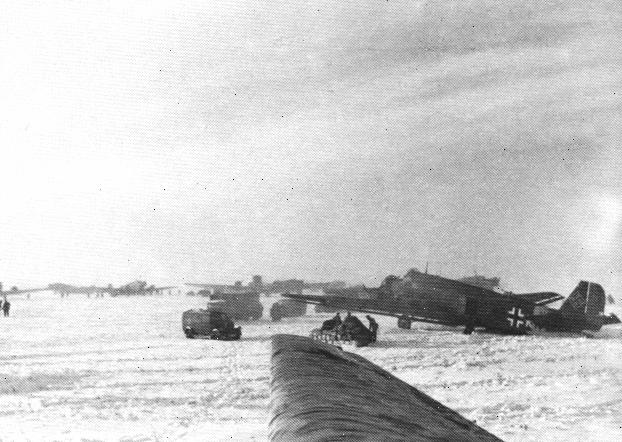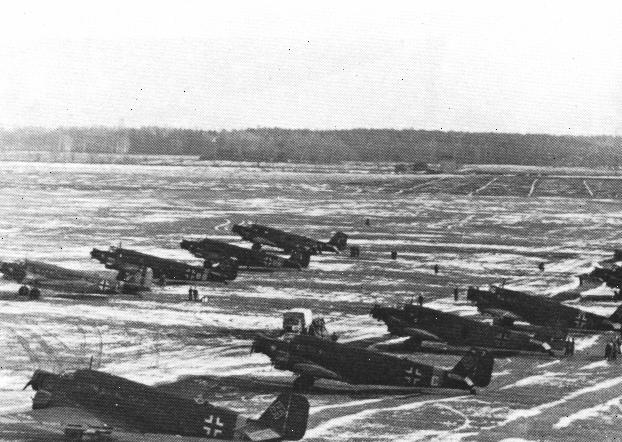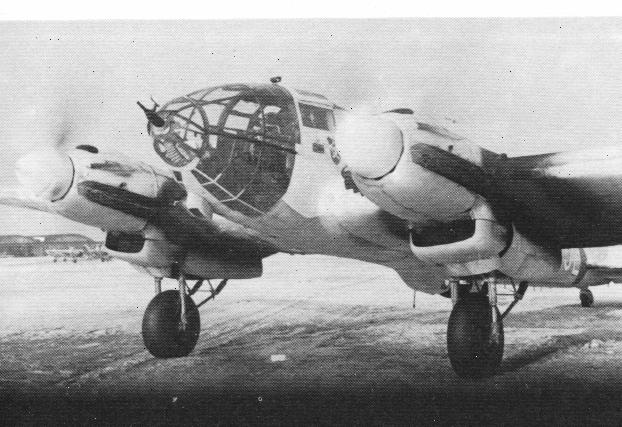|
To
supply Sixth Army with 300 tons a day, the absolute
minimum amount demanded by
the army (which really needed 500 tons) would
necessitate an average of 150 fully laden
Ju 52s landing in the pocket each day. Of course,
because weather would prevent that
tonnage being airlifted on many days, far more than 300
tons would have to be carried in
during good weather. Loading and unloading supplies was
time-consuming, so each
plane could fly only one, or perhaps two missions a day.
Therefore, because an operational
rate of only 30 to 40 percent could be counted on,
Richthofen needed at least 800 Ju 52s
to fulfil Goring's promises an meet Sixth Army's barest
needs.

Few of the new pilots
were accustomed to flying in temperatures so cold that
their planes iced
up as they entered low-lying cloud formations. For the
first weeks of the airlift, however,
poor visibility caused by snowstorms, fog, and low cloud
hampered Luftwaffe operations
more than the cold. Taking off was dangerous and
difficult, but even experienced pilots
hated having to land their fully laden planes inside the
"fortress" during the frequent periods
of poor visibility. Thick fog shrouding Pitornnik and
Basargino (the main airfields within the
pocket) often forced even the most courageous pilots to
turn back without attempting to land,
despite the presence of radio beacons at each field.
Of the seven airfields
inside the pockets, only Pitomnik was properly equipped
to handle
large-scale operations. It even had lights, flare paths,
and signals equipment for night
operations. The others, with the exception of Basargino,
which Generalmajor Pickert
(Commander of the 9th Flak Division) hastily equipped
with the minimum requirements were
no more than bare grass landing strips, lacking all
necessary communications and air traffic
control equipment. Several of those fields had been used
in previous months to supply Sixth
Army as it advanced into Stalingrad, but the quantities
of supplies carried were never large
and the weather had been satisfactory. Now, those soggy,
snow-covered fields were virtually
worthless to the Luftwaffe.

Pickert worked tirelessly
to ensure that his two main airfields functioned as
efficiently as
possible and that the off-loading and transfer of
supplies was always handled smoothly
and quickly. He took his job seriously, realizing that
the lives of an entire army depended
on the Luftwaffe's ability to keep it supplied and fed.
"The Pitomnik airfield has become my
main sphere of activity," he wrote in his journal
on 26 November. "All momentum here is
focused on the air supply operation, evacuation of the
wounded, and their accommodation
until they can be flown out." The plight of the
wounded moved him deeply. When he had
first arrived at Pitomnik two days earlier, he saw
"tragic scenes of freezing wounded, waiting
with their nurses for evacuation." For the next two
months, he would frequently refer to the
hundreds of wounded soldiers waiting each day to be
placed in transport planes and carried
out of the pocket for medical attention. Many died
beside the runways, especially on days
when weather conditions curtailed air operations.
Pickert stationed a heavy
flak battery at the main airfield and ordered all the
light batteries
that Sixth Army had not already positioned along the
pocket's outer perimeter to dig
themselves in around the main airfields. "This is
no easy task in the steppe," he noted, "
because there is almost no wood and the ground is frozen
solid."" The flak teams must
protect transport aircraft from enemy attack at all
costs, he insisted, especially when they
were most culnerable during takeoff and landing. By the
end of November, Soviet fighters,
ground-attack planes and bombers were sigling out
Pitomnik for heavy attacks, clearly aware
of its importance tot the airlift operation.

|